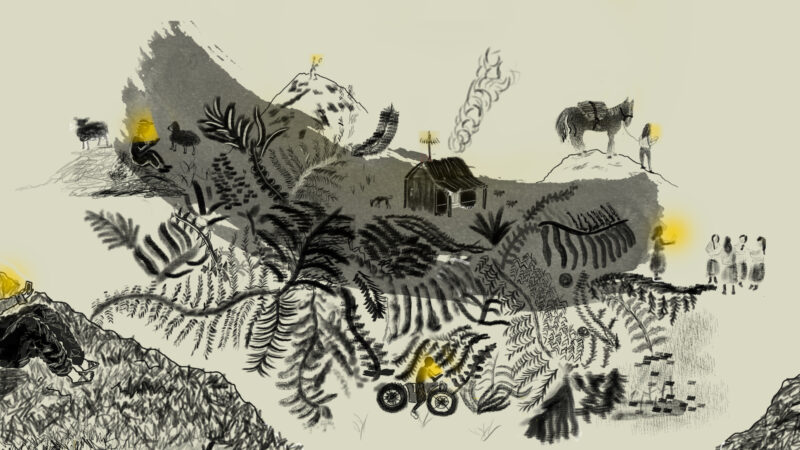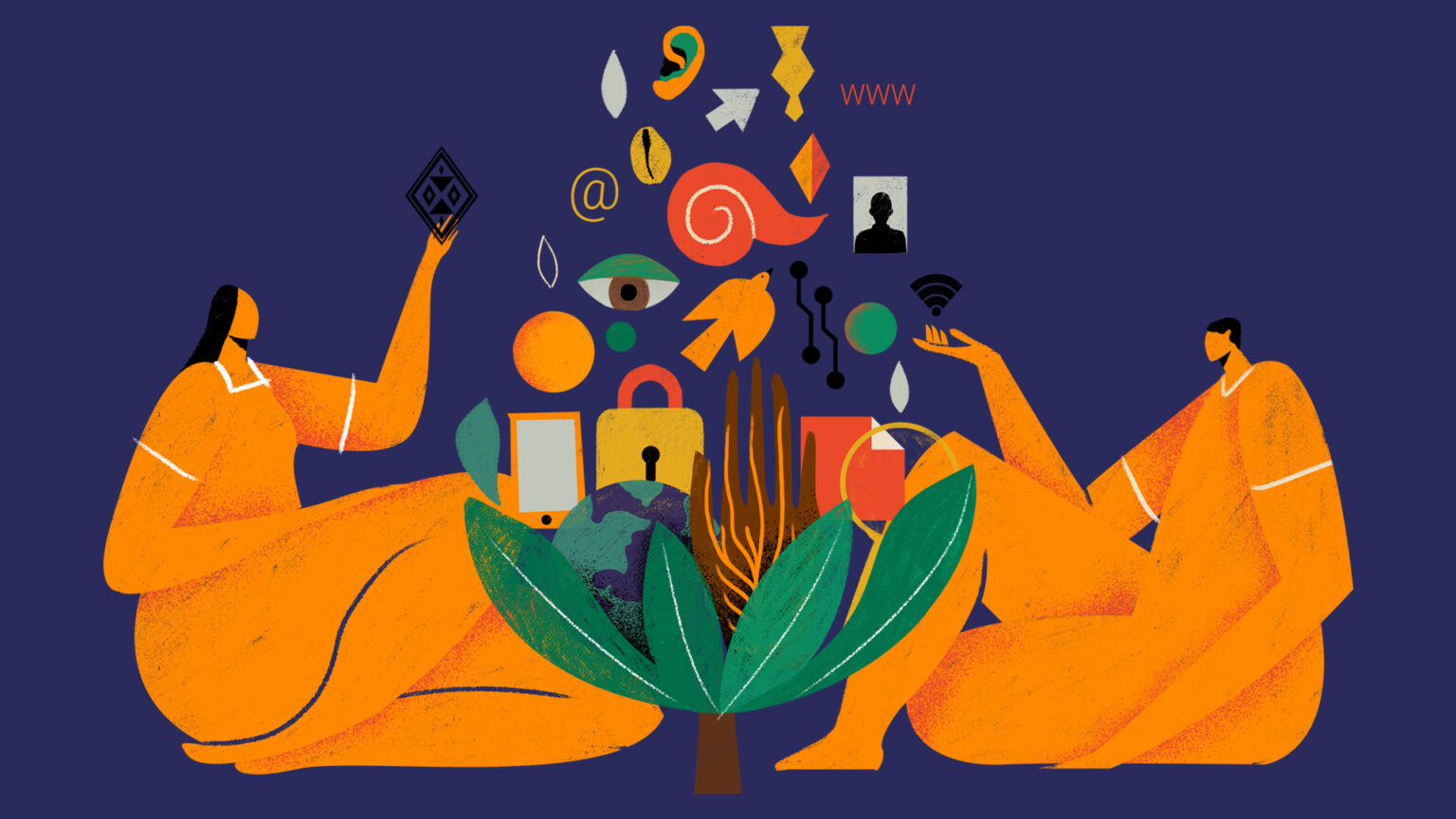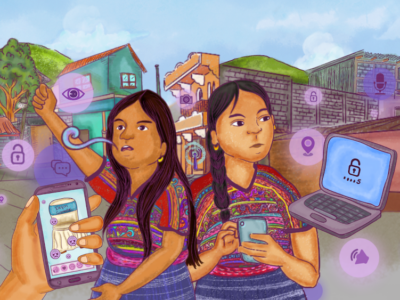
Illustration by Sara Yatiní Domínguez Cruz for Rising Voices
A version of this article will soon be available in Zapotec (Zapoteco de la Sierra Sur Central – Diiste)
Based on the “Managing Facebook Privacy. Strategies of young Zapotecs from El Carrizal Paxtlán” study by Rodrigo Pérez Ramírez and on conversation with the author.
The language at a glance
“Zapotec is a macro-language made up of different Zapotec languages (62 linguistic variants, note: including the variant Zapoteco de la Sierra Sur Central – Diiste which is the focus of this study) some 777,253 people in Oaxaca and elsewhere as registered in the year 2000. Together with Chatino, it forms part of a linguistic group that belongs to the Otomanguean branch of Mesoamerican languages, along with Mixtec, Mazatec and Popoloca, among others. Zapotec languages are spoken mainly in the states of Oaxaca and in the southeastern region of Veracruz, in southern Mexico.” – Wikipedia
Recognition: The macrolanguage Zapotec is one of the 68 Indigenous Languages recognized as “National Languages”
Digital security resources in this language:
- None identified
Digital security tools in this language:
- Signal ❌
- TOR ❌
- Psiphon ❌
Internet access in El Carrizal Paxtlán, in the Sierra Sur of Oaxaca, is a recent development. In 2019 this Men Diiste (Zapotec people) community started using the internet, and along with it, social media, while creating new strategies for safety in this digital territory. This is the analysis by Rodrigo Pérez Ramírez, a researcher and member of this community, in his study on the specific case of Facebook.
Rodrigo is an agricultural engineer and digital activist, committed to making the internet a space for linguistic diversity. His research “Management of Privacy on the Facebook social network by young Zapotecs from El Carrizal Paxtlán, Oaxaca” answers a central question: How do the young people of the Zapotec community manage their privacy on this platform?
For Rodrigo, the answers to this question must first take into account the Indigenous rural context of this community, in contrast to the urban contexts where reflections on digital security and privacy are generally focused. He explains that:
“The daily context in the Indigenous and rural communities is totally different from the urban context. It is closely linked to the way of life and the worldview.”
Acknowledging the rural context of participants’ lives also implies recognizing community life in relation to the territory, as well as its demographic and linguistic conditions. In the community of El Carrizal there are 319 inhabitants, 145 women and 174 men, and 98.75 percent of the population identify as Indigenous, out of whom 71.79 percent speak an Indigenous language and Spanish, and only 1.88 percent do not speak Spanish (INEGI, 2020b).
The young people who participated in the study are two women and two men between 21 and 29 years of age. For Rodrigo one of the main conclusions of the in-depth interviews with each of them is that the use of social networks is not a central activity in participants’ lives: they mentioned accessing them only in their leisure time, which is limited due to them being engaged in their main occupations (which are agriculture and domestic work). The research also highlights his finding that Facebook is not the most used social network for the participants, who prefer to use WhatsApp for messages and YouTube for training and entertainment.
Although the number of people interviewed is small and it would be a mistake to generalize their perspective to the rest of the community, their experiences present us with certain ideas to think about privacy and the use of this social network from this local context. For example, the idea that Facebook is not central to communication in the territory — if at all, it is useful to communicate abroad. Also, as Rodrigo emphasizes, it is important to mention that there are already established forms and spaces of communication in the community, such as the assembly, the tequio, and the use of the Zapotec language.
Adding to these contextual considerations, Rodrigo analyzes two conditions that are central to exploring the use of digital tools and privacy strategies in his community. On the one hand, there is a structural inequality in access to telecommunications in Indigenous rural contexts; on the other hand, the ability of users to create safety strategies for the use of digital tools even when access to the internet is limited and information is very sparse and even less accessible in their mother tongue.
Expensive and limited internet
In El Carrizal, as in most rural and Indigenous communities in Mexico, internet access is limited and expensive. As Rodrigo explains, this is also the case with basic services, such as healthcare, which are mostly centralized in urban populations.
“Regarding communication, households have the following characteristics: 39.19 percent have a radio, 55.41 percent have a television, 2.7 percent have a computer or laptop, and 4.05 percent have a landline telephone. The data also reveal that 55.41 percent have a mobile phone and only 6.76 percent have Internet access at home through broadband satellite service” (Inegi, 2020b).
As the data presented by the study shows, for the people who live in El Carrizal, internet access is no guarantee of communication. Rodrigo explains that internet access is not via cable or fiber optics, but by satellite, because many remote rural areas are not profitable for companies or the state. Rodrigo explains that there is no internet access by cable or fiber optics, but by satellite, as in many rural areas that are remote and unprofitable for companies and the State. Therefore, the community does not have broadband internet services, and it can only access the internet through private services with airtime cards and by renting computer equipment offered by a single establishment in the community. Another way to access the internet is by purchasing an antenna and a monthly rental of the satellite service, or traveling approximately four kilometers to the upper parts of the community area to access the 3G and 4G networks with mobile devices.
Rodrigo states that these conditions
“limit the expansion of telecommunications networks and infrastructure, maintaining connectivity access gaps in marginalized rural sectors with lower incomes.”
This is also demonstrated by the testimonies of the people interviewed. As one of them comments:
“I connect through the WiFi network of a local provider and I pay 250 pesos (12 USD) per month, but the signal is very bad, there are many people connected to a single antenna and when it is cloudy or rainy there is no signal, but you continue paying for the service.”
Another interviewee explains that
“connecting to the internet is expensive, I paid 4,500 pesos (225 USD) for the antenna with a monthly fee of 450 pesos (22 USD). First, I used it for the local office and I shared it with my colleagues on the committee and some students; by the end of the month they voluntarily supported me with the fee and I paid around 250 pesos.”
Thus, although people create strategies to make the service more affordable, the cost of internet access is high and the quality is low or unstable.
Privacy and security from El Carrizal
In this context of limited access, how do the young people of El Carrizal Paxtlán manage their privacy when using Facebook? An initial hypothesis in the investigation was that the limited access to information on the use and configurations of the platform — and to the internet itself — resulted in minimal or no security practices for users. However, the study revealed a different situation:
“Although there is a lack of knowledge about the protection and privacy mechanisms on devices and in platform configurations, there is an awareness about the issues caused by sharing personal data on the Facebook social network, and they apply protection systems that come from a broader understanding of security.”
Some of the examples relate to preventative strategies such as interacting only with known people, or acquaintances, and limiting the use of profile photos. As one participant explained:
“I have learned from the news what is happening with Facebook, so I try not to use it much, I do not post photos of myself and I only send or reply to messages from friends or family.” Another participant shared that: “I do not adjust my privacy settings in my profile, but I do not post a profile picture and I do not give more information other than my abbreviated name. I also don't have many contacts, except for some relatives and friends and if I don't know the person who sends me the request, I don't accept it.”
The people interviewed have their own strategies based on their experiences with vulnerability when using the platform. For the researcher, this reveals that young people in their community already engage in safety and security practices. However, some of these practices imply that these users assume a passive role with the internet, since it is more used to access other people's content than to create or disseminate information from the territory, language and daily life. What would internet use by the people in El Carrizal be like if they had information on digital strategies to actively participate on platforms such as Facebook? How would this impact the creation and dissemination of digital content from the territory? And what would be the effect on the linguistic and cultural diversity discussed on the internet?
Rodrigo considers that the strategies of limited use that people adopt may be related to the content created by the majority of users on the internet today, which reflects an almost monolingual environment (either in Spanish or English) that denies users of other languages the comfort level to be active users and share their points of view. He asked the interviewees if it would be good if Facebook were in Zapotec. For some, accessing and creating digital content in Zapotec would be a way to preserve the language. For others, the platform is focused too much on reading and writing, so it is not able to convey the orality of the language, which becomes a potential limitation for people who speak Zapotec but do not write it.
Considering these various perspectives, I asked Rodrigo if it would be different for him if content on the internet were in his language. His answer was:
“For me it would be, I would feel safer, more comfortable in my environment. Sometimes I feel that my physiognomy, my face, does not fit there. A platform in different languages would create a feeling of confidence for the users to experience a space that respects and promotes diversity.”
The relationship between digital security and linguistic diversity seems to be a peripheral issue in digital security discussions that take place in urban contexts, and from the same dominant languages in the online and offline world. Therefore, as Rodrigo argues, it is necessary to recognize and position the diversity of contexts and territories when talking about digital security and privacy on the internet, as well as when thinking about the information necessary to promote the security of the users of the different platforms.
To promote these conditions that recognize diversity, Rodrigo shares the following key strategies as recommendations:
- Research and discussions must include Indigenous people who speak the language and have a better understanding of what is happening in their territories.
- Create spaces for people to express what they feel, seek, desire and share their own interpretation of reality, and how they conceive of and appropriate these technologies.
Although people in rural and Indigenous contexts like those of El Carrizal assume and create their own strategies to feel safe when using platforms like Facebook, what are we losing when these strategies focus on limiting people's participation? What is lost when the diversity of languages that exist in the world do not find a safe space on digital platforms? Can we create, as Rodrigo says, processes that recognize and focus on linguistic diversity when designing and promoting digital security strategies?
References
- Instituto Nacional de Estadística Geografía e Información (INEGI, 2020a). Aspectos geográficos de Oaxaca. https://inegi.org.mx/programas/ccpv/2020/#Tabulados
- Instituto Nacional de Estadística y Geografía (INEGI, 2020b). Encuesta Nacional sobre Disponibilidad de Tecnologías de la Información en los Hogares. https://www.inegi.org.mx/programas/dutih/2020/
For more stories and information from participating language communities, please visit the “Digital Security + Language” project page



